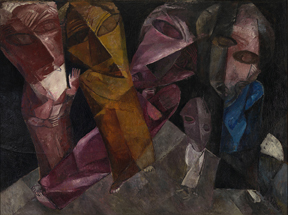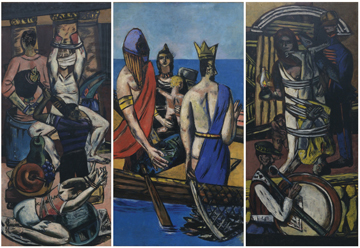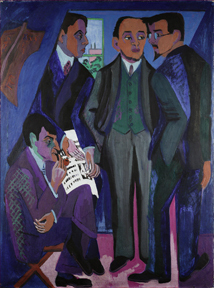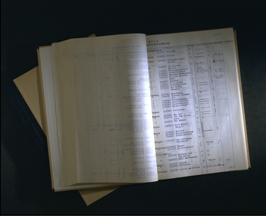Artists are often dismissed as peripheral to society. Yet they continue on their way, attending to the path of their own visions. Often ahead of the curve, politically and culturally, they frequently function as commentators -- viewing society from the outside. In certain instances, they become players in historical events larger than themselves.
Renée Price, Director of the Neue Galerie New York, wrote the following letter for the Degenerate Art exhibit brochure:
In mounting this exhibition, the Neue Galerie aspires to shed new light on a very dark period of German history. Examining the place where politics and culture intersected in spectacular, brutal, and extreme fashion, we are led to commit again to the values we believe must be defended. Our sincere hope is that, by uncovering the full history of the Nazi attack on modern art, we will help point the way to a future in which such an assault will not be tolerated.
The show operates on several different levels. In 21st century terminology, it is a mashup of history, psychology and art. It was organized by Dr. Olaf Peters, a German art historian and scholar. In addition to paintings, sculptures and works on paper, there are posters, photographs, items of documentation and video. There is footage of the original "Entartete Kunst" (Degenerate Art) show, taken by American cameraman Julien Bryan. Examples of works from various modern art movements are included: Expressionism, Surrealism, Dada, Cubism and the Bauhaus. The installation has been conceived with the utmost detail -- setting a tone that will immerse visitors in the zeitgeist of Nazi Germany.
A continuous video loop shows a segment from the film The Eternal or Wandering Jew (Der ewige Jude), directed by Fritz Hippler in 1940. A propagandistic diatribe promoted as a documentary, it depicted Jews as rats polluting the German nation. It linked the themes of Jewish cultural infiltration of Germany society to the negative impacts of African influences on art, and to American blacks on music -- such as jazz.
Lasar Segall
Eternal Wanderers, 1919
Lasar Segall Museum, IBRAM/Ministry of Culture
Photo: Jorge Bastos
When descending a staircase, a light-boxed photograph from 1938 resides in a recessed window, documenting Hitler and top Nazi officials scrutinizing "confiscated art." On the subsequent downward landing is another photograph similarly displayed. It records Jewish people trying to emigrate from Vienna that same year.
Upon entering the exhibit, a timeline traces the course of German history from July 1932, when the Nazi Party won the greatest number of representatives in the Parliament, to September 1939, when Germany invaded Poland. Interspersed are notations of the dates when specific artists resigned from prominent positions, were dismissed or self-exiled.
In a narrow hallway, a large photomural of Jewish people arriving in Auschwitz-Birkenau in 1944 is mounted. Opposite are five large, bold posters -- with the predominating colors of red, black and tan. The 1933 Stormtroopers/Brownshirts by Sepp Semar is chilling.
Using the metaphor of color to reflect the darkness of events, a room painted charcoal grey has a photographic backdrop of the 1933 book burnings in Berlin. The title sets the tone: "Collaborators and Combattants: German Artists Under the Reich." It was shocking for me to learn that Emil Nolde, originally a Danish citizen and the creator of the powerful woodcut The Prophet, had joined a Nazi "splinter" group in 1934. He was also the author of numerous anti-Semitic tracts. Despite his allegiances, his works met with Hitler's disfavor and were purged from museums, several ending up in the Degenerate Art exhibit.
The spotlight of the large room entitled, "German Versus 'Degenerate Art,'" is the juxtaposition of Adolf Ziegler's triptych The Four Elements: Fire, Earth and Water, Air (1937) with Max Beckmann's Departure (1933-1935). Ziegler gladly took on the plum assignment of putting together the Degenerate Art show for the Nazis. The Four Elements, owned by Hitler and shown at the 1937 "Great German Art Exhibition," is a pastiche of academic classicism and Aryan idealization.
Adolf Ziegler
The Four Elements:
Fire (left wing), Earth and Water (center panel), Air (right wing), 1937
Pinakothek der Moderne, Bayerische Staatsgemaeldesammlungen, Munich
Photo: bpk, Berlin/Art Resource, NY
Departure uses allegory as well, but not the soothing contours of human figuration as romanticized perfection. Rather, it enumerates torture, sadism, dismemberment, brutality, and captivity -- all precursors of the state sanctioned activities to come. In the panel on the right, a musician beats a drum, unperturbed by the violent action taking place on the stage above him. The panel on the left has trussed and gagged figures, one with bloody stumps where arms had been. Only in the center scene is there some hope for equanimity, as a crowned man, a woman, and a child are all ferried by a masked oarsman -- potentially to a better place somewhere on the cloudless blue horizon. (Beckmann took refuge in Amsterdam in 1937.)
Max Beckmann
Departure, Frankfurt 1932, Berlin 1933-35
The Museum of Modern Art, New York. Given anonymously (by exchange)
Digital Image © 2014 The Museum of Modern Art/Licensed by SCALA/ Art Resource, NY
© 2014 Artists Rights Society (ARS), New York/VG Bild-Kunst, Bonn
The works in the section "Dresden and the Development of Modernism" deal with the movement of Die Brücke (The Bridge). Founded in this city by Karl Schmidt-Rottluff, Ernst Ludwig Kirchner, Fritz Bleyl and Erich Heckel, it was where it would later be the most vehemently attacked. Kirchner, who had suffered a nervous breakdown during his service in World War I, could not cope with the ostracization of his work by the Nazis. In June of 1938, he committed suicide.
Ernst Ludwig Kirchner
A Group of Artists (The Painters of the Brücke), 1925-26
Museum Ludwig, Cologne
Photo: © Rheinisches Bildarchiv Cologne
The Exhibition of Shame, a precursor to the Degenerate Art show, was independently organized in 1933. Artists whose work had been overlooked, while those experimenting on the cutting edge had been favored, savored a measure of payback.
In the final room, empty frames are accompanied by labels of paintings that have been destroyed or lost. On the wall is the statement, "Art policy became an integral component of National Socialism's war on everything supposedly 'un-German.'" Loaned from the Victoria and Albert Museum in London is Volume 1 (A-G) of the "Entartete Kunst," a typed record of the inventory of works confiscated by the Nazis from German public institutions. With utmost precision, it documents location, institution, artist, and the "fate of each work." An "X" indicates destruction.
Photograph of the two volumes
© Victoria and Albert Museum, London
Within this setting, George Grosz, well-known for his depictions of military corruption and the excesses of the Weimar Republic in his drawings and prints, is represented by three oil portraits. Portrait of the Writer Max Hermann-Neisse (1925) was removed from a German museum. Ironically, it was purchased by the same museum after the war. Otto Dix, who also painted scathing anti-war narratives, had his War Cripples (1920) plucked for the Degenerate Art show. Subsequently destroyed, it is represented by a black and white reproduction.
Although he was not a part of the Degenerate Art show, Felix Nussbaum (the subject of an extensive exhibition, Art and Exile, at The Jewish Museum in 1985) is represented. His painting, The Damned (1943/5 January 1944) gives his interpretation of life under the Nazis as both artist and hunted Jew. It depicts a scene with Nussbaum in the foreground, recognizable from a similar pose in his well-known Self Portrait with Jewish Identity Card. Others surround him in various emotional states, displaying a continuum of responses to their situation -- fear, horror, despair and resignation. High brick walls confine them; a street with tattered flags leads nowhere. Skeletal pallbearers escort a procession of empty coffins. Nussbaum, his wife, and extended family were murdered in the death camps.
The attack against Degenerate Art struck free thought and artistic expression at its core. It went far beyond the defamation of artists and their work. It was state-sanctioned Orwellian groupthink that was intrinsic to building the mentality that would create fertile ground for marginalizing "the other," -- whether they were Jewish, Gypsies, the mentally ill, the gay community or political dissidents.
The 20,000 works of confiscated art, along with the 5,000 pieces that were destroyed, were both a precursor and a sideshow to the actual extermination and nightmare that was to follow.
Oskar Kokoschka
Poster with Self-Portrait for Der Sturm magazine, 1910
© Neue Galerie New York. Gift of Leonard A. Lauder
© 2014 Fondation Oskar Kokoschka/Artists Rights Society (ARS),
New York/ ProLitteris, Zürich
Neue Galerie
Extended through September 1
1048 Fifth Ave
New York, NY






